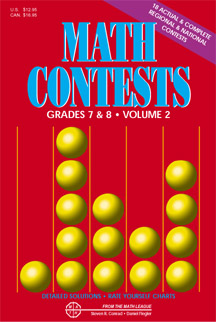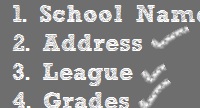Area and Perimeter
- Details
- Parent Category: Math League Website
- Published: 15 September 2008
The area of a figure measures the size of the region enclosed by the figure. This is usually expressed in terms of some square unit. A few examples of the units used are square meters, square centimeters, square inches, or square kilometers. Area and perimeter
Area
Area of a square
Area of a rectangle
Area of a parallelogram
Area of a trapezoid
Area of a triangle
Area of a circle
Perimeter
Circumference of a circle
Area
If l is the side-length of a square, the area of the square is l2 or l × l. Example: What is the area of a square having side-length 3.4? The area of a rectangle is the product of its width and length. Example: What is the area of a rectangle having a length of 6 and a width of 2.2? The area of a parallelogram is b × h, where b is the length of the base of the parallelogram, and h is the corresponding height. To picture this, consider the parallelogram below:
Area of a Square
The area is the square of the side-length, which is 3.4 × 3.4 = 11.56.
Area of a Rectangle
The area is the product of these two side-lengths, which is 6 × 2.2 = 13.2.
Area of a Parallelogram
We can picture "cutting off" a triangle from one side and "pasting" it onto the other side to form a rectangle with side-lengths b and h. This rectangle has area b × h.

Example: What is the area of a parallelogram having a base of 20 and a corresponding height of 7?
The area is the product of a base and its corresponding height, which is 20 × 7 = 140.
Area of a Trapezoid
If a and b are the lengths of the two parallel bases of a trapezoid, and h is its height, the area of the trapezoid is To picture this, consider two identical trapezoids, and "turn" one around and "paste" it to the other along one side as pictured below:
1/2 × h × (a + b) .
The figure formed is a parallelogram having an area of h × (a + b), which is twice the area of one of the trapezoids. Example: What is the area of a trapezoid having bases 12 and 8 and a height of 5? Consider a triangle with base length b and height h. To picture this, we could take a second triangle identical to the first, then rotate it and "paste" it to the first triangle as pictured below: The figure formed is a parallelogram with base length b and height h, and has area b × ×h. Example: What is the area of the triangle below having a base of length 5.2 and a height of 4.2?
Using the formula for the area of a trapezoid, we see that the area is
1/2 × 5 × (12 + 8) = 1/2 × 5 × 20 = 1/2 × 100 = 50.
Area of a Triangle
or
The area of the triangle is 1/2 × b × h. or
This area is twice that of the triangle, so the triangle has area 1/2 × b × h.
The area of a triangle is half the product of its base and height, which is 1/2 ×5.2 × 4.2 = 2.6 × 4.2 = 10.92..
The area of a circle is Pi × r2 or Pi × r × r, where r is the length of its radius. Pi is a number that is approximately 3.14159. Example: What is the area of a circle having a radius of 4.2 cm, to the nearest tenth of a square cm? Using an approximation of 3.14159 for Pi, and the fact that the area of a circle is Pi × r2, the area of this circle is Pi × 4.22 The perimeter of a polygon is the sum of the lengths of all its sides. Example: What is the perimeter of a rectangle having side-lengths of 3.4 cm and 8.2 cm? Since a rectangle has 4 sides, and the opposite sides of a rectangle have the same length, a rectangle has 2 sides of length 3.4 cm, and 2 sides of length 8.2 cm. The sum of the lengths of all the sides of the rectangle is 3.4 + 3.4 + 8.2 + 8.2 = 23.2 cm. Example: What is the perimeter of a square having side-length 74 cm? Since a square has 4 sides of equal length, the perimeter of the square is 74 + 74 + 74 + 74 = 4 × 74 = 296. Example: What is the perimeter of a regular hexagon having side-length 2.5 m? A hexagon is a figure having 6 sides, and since this is a regular hexagon, each side has the same length, so the perimeter of the hexagon is 2.5 + 2.5 + 2.5 + 2.5 + 2.5 + 2.5 = 6 × 2.5 = 15m. Example: What is the perimeter of a trapezoid having side-lengths 10 cm, 7 cm, 6 cm, and 7 cm? The perimeter is the sum 10 + 7 + 6 + 7 = 30cm. The distance around a circle. It is equal to Pi ( Example: What is the circumference of a circle having a diameter of 7.9 cm, to the nearest tenth of a cm? Using an approximation of 3.14159 for
Area of a Circle
 3.14159 × 4.22 =55.41…square cm, which is 55.4 square cm when rounded to the nearest tenth.
3.14159 × 4.22 =55.41…square cm, which is 55.4 square cm when rounded to the nearest tenth.
Perimeter
Circumference of a Circle
) times the diameter of the circle. Pi or
is a number that is approximately 3.14159.
, and the fact that the circumference of a circle is
times the diameter of the circle, the circumference of the circle is Pi × 7.9
 3.14159 × 7.9 = 24.81…cm, which equals 24.8 cm when rounded to the nearest tenth of a cm.
3.14159 × 7.9 = 24.81…cm, which equals 24.8 cm when rounded to the nearest tenth of a cm.




